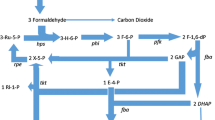Abstract
Concentration of methanol in the medium strongly affected not only the physiology but also the cytology ofCandida boidinii strain 2 cells in a methanol-limited chemostat at a constant dilution rateD 0.1/h and at low pH 3.0. The formation of large cubic peroxisomes with high alcohol oxidase (AO) activity observed at low methanol concentration (S 0 3 g/L) disappeared on increasing the methanol concentration in the inflow medium. The AO activity in the cells sharply decreased, followed by accumulation of riboflavin phosphate and residual methanol in the medium. The activity of catalase was relatively stable. At methanol concentrationS 0>K I (K 1 equal to 12 g methanol per L), which included a substantial increase in methanol dissimilation, documented by higher formaldehyde and formate dehydrogenase activities and by lower yield coefficient on methanol, the yeast cells contained large lobe-shaped peroxisomes and a smaller number of larger mitochondria. The cells formed pseudomycelium with a thick septum between the mother and daughter cells.
Similar content being viewed by others
References
Aminova L.R., Kysl’ikov’a E., Volfov’a O., Trotsenko Y.A.: Characterization of catalase-negative mutants of methylotropic yeastHansenula polymorpha.Folia Microbiol. 36, 158–163 (1991).
Bystrykh L.V., Romanov V.P., Steczko J., Trotsenko Y.A.: Catalytic variability of alcohol oxidase from the methylotrophic yeastHansenula polymorpha.Biotech. Appl. Biochem. 11, 184–192 (1989).
Douma A.C., Veenhuis M., Koning W., de Evers M., Harder W.: Dihydroxyacetone synthase is localized in the peroxisomal matrix of methanol-grownHansenula polymorpha.Arch. Microbiol. 143, 237–243 (1985).
Goodman J.M.: Dihydroxyacetone synthase is an abundant constituent of the methanol-induced peroxisome ofCandida boidinii.J. Biol. Chem. 260, 7108–7113 (1985).
Harder W.: Structure/function relationships in methylotrophic yeasts.FEMS Microbiol. Rev. 87, 191–200 (1990).
Lam F.L., Lowande A.: The simultaneous assay of riboflavin 5-phosphate sodium and their water-soluble vitamins in liqui multivitamin formulations by liquid chromatography.J. Pharmac. Biomed. Anal. 6, 87–95 (1988).
Lück H.: Catalase, pp. 885–894 inMethods of Enzymatic Analysis (H.V. Bergmeyer, Ed.). Academic Press, New York-London 1963.
Reynolds E.S.: The use of lead citrate at high pH as an electron-opaque stain in electron microscopy.J. Cell Biol. 17, 208–212 (1963).
Roggenkamp R., Sahm H., Hinkelmann W., Wagner F.: Alcohol oxidase and catalase in peroxisomes of methanol-grownCandida boidinii.Eur. J. Biochem. 59, 231–236 (1975).
Tani Y., Miya T., Nishikawa H., Ogata K.: The microbial metabolism of methanol. Part 1. Formation and crystalization of methanol-oxidizing enzyme in a methanol utilizing yeast,Kloeckera sp. no. 2201.Agric. Biol. Chem. 36, 68–75 (1972).
Veenhuis M., van Dijken J.P., Pilon S.A.F., Harder W.: Development of crystalline peroxisomes in methanol-grown cells of the yeastHansenula polymorpha and its relation to environmental conditions.Arch. Microbiol. 117, 153–163 (1978).
Veenhuis M., Goodman J.M.: Peroxisomal assembly: membrane proliferation precedes the induction of the abundant matrix protein in the methylotrophic yeastCandida boidinii.J. Cell. Sci. 96, 583–590 (1990).
Veenhuis M., Harder W.: Metabolic significance and biogenesis of microbodies in yeasts pp. 436–458 in H.D. Fahini, H. Sies (Eds),Peroxisomes in Biology and Medicine. Academic Press, London 1987.
Veenhuis M., Harder W., van Dijken, J.P., Meyer F.: Substructure of crystalline peroxisomes in methanol-grownHansenula polymorpha: evidence for anin vivo crystal of alcohol oxidase.Mol. Cell. Biol. 1, 949–954 (1981).
Veenhuis M., Keizer I., Harder W.: Characterization of peroxisomes in glucose-grownHansenula polymorpha and their development after the transfer of cells into methanol-containing media.Arch. Microbiol. 120, 167–175 (1979).
Volfov’a O.: Studies on methanol-oxidizing yeasts. III. Enzymes. Folia Microbiol.,20, 307–319 (1975).
Volfov’a O., Kmentov’a M., Kysl’ikov’a E.: Acidotolerant strainCandida boidinii 2 utilizing methanol—characterization and biomass composition. (In Czech)Kvas. prům. 34, 330–331 (1988).
Volfov’a O., Pil’at P.: Studies on methanol-oxidizing yeast. I. Isolation and growth studies.Folia Microbiol. 19, 249–256 (1974).
Zwart K.B., Veenhuis M., Plat G., Harder W.: Characterization of glyoxysomes in yeasts and their transformation into peroxisomes in response to changes in the environmental conditions.Arch. Microbiol. 136, 28–38 (1983).
Author information
Authors and Affiliations
Rights and permissions
About this article
Cite this article
Volfov’a, O., Žižka, Z. & Andêrov’a, M. Effect of increasing methanol concentrations on physiology and cytology ofCandida boidinii . Folia Microbiol 37, 413–420 (1992). https://doi.org/10.1007/BF02899899
Received:
Issue Date:
DOI: https://doi.org/10.1007/BF02899899




